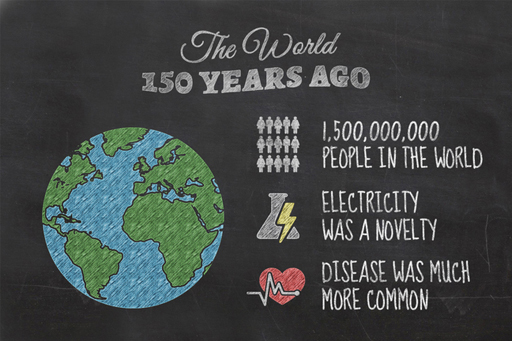1.3 We’re all scientists now
Consider how the world was 150 years ago. You could probably have lived quite well without understanding numbers beyond 100 (although there were 12 pence to the shilling and 20 shillings to the pound, so it wasn’t all easy maths in those days), but you might have been better informed if you had known a few numbers.
That was a world of about one and a half billion people (1,500,000,000, a number that you’ll be able write in scientific notation later this week), compared to over seven billion people (7,000,000,000) today. Infant mortality was high, with somewhere between 10 and 15 out of every 100 babies dying before their first birthday. Disease was much more common, and even just over 150 years ago in 1854, over 600 people died in an outbreak of cholera in Soho, London, at a time when science didn’t understand what caused disease. Perhaps more impressive and deadly was the influenza outbreak of 1918 that killed at least 50 million people (50,000,000), which was 3% of the world’s population at the time.
A lot has changed since then. Most of our modern comforts and some amazing scientific discoveries have come about through the application of scientific thinking in medicine, engineering, food science and electronics. While this is marvellous for us, there is a risk involved, as described by the astronomer, Carl Sagan:
We live in a society exquisitely dependent on science and technology, in which hardly anyone knows anything about science and technology.
Numbers are everywhere, not just to count from 1 to 10, or even to 100, but to describe the electric charge carried by electrons, the basis of electricity, or the amount of water in the world’s oceans. Numbers appear in the media, in our jobs, and even just in our daily lives, whether in relation to an environmental crisis, the outcomes of a medical trial, or the special offer on cheese at your local supermarket.
Numbers matter, and scientists expend a lot of effort quantifying the world in order to understand it. As an example, numbers tell us a lot about life, or rather the difference between different forms of life. How many genes are there in human DNA compared with the number of genes in fruit fly DNA, or yeast DNA? The number of genes doesn’t describe everything, it’s their interactions which produce the final result, but it is a start. Are you wondering about that? How to test it? What numbers might mean? Now, you’re a scientist.

